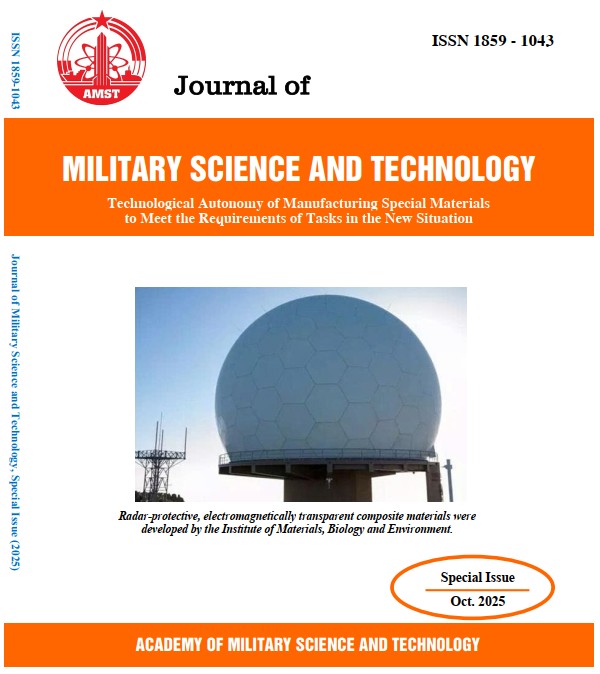Quá trình hoạt hóa nhiệt hóa tạo carbon có nguồn gốc từ bã mía sử dụng HCl để loại bỏ thuốc nhuộm methylene blue
DOI:
https://doi.org/10.54939/1859-1043.j.mst.IMBE.2025.108-114Từ khóa:
Than hoạt tính; Bã mía; Hoạt hóa nhiệt hóa; Xanh methylen; Hấp phụ; Xử lý nước thải.Tóm tắt
Nghiên cứu này mô tả cách tạo than hoạt tính (AC) từ bã mía bằng cách xử lý với axit clohydric (HCl) và ứng dụng loại bỏ thuốc nhuộm xanh methylen (MB) khỏi nước. Bã mía được ngâm trong 7% HCl và cacbon hóa ở 450 °C để tạo ra vật liệu hấp phụ carbon xốp. Các thử nghiệm cho thấy vật liệu có cấu trúc với các lỗ nhỏ, diện tích bề mặt lớn 473,8 m²/g, nhiều nhóm oxy với carbon vô định hình. Các thử nghiệm được tiến hành đánh giá ảnh hưởng của thời gian tiếp xúc, đến hiệu quả loại bỏ thuốc nhuộm. AC đã chứng minh khả năng hấp phụ nhanh, đạt được 95,6% loại bỏ MB trong vòng 20 phút ở nồng độ đầu là 10 mg/L. Dữ liệu động học phù hợp hơn với mô hình bậc hai giả, cho thấy sự hấp phụ hóa học là cơ chế chủ đạo. Phân tích đẳng nhiệt hỗ trợ hành vi hấp phụ thuận lợi. Kết quả cho thấy carbon làm từ bã mía hoạt hóa bằng HCl là một lựa chọn tốt, thân thiện với môi trường và không tốn kém để loại bỏ thuốc nhuộm cation trong nước thải. Hiệu suất đầy hứa hẹn của nó làm nổi bật tiềm năng của nó trong các quy trình xử lý thuốc nhuộm công nghiệp.
Tài liệu tham khảo
[1]. Dutta, S., et al. “Contamination of textile dyes in aquatic environment: Adverse impacts on aquatic ecosystem and human health, and its management using bioremediation.” Journal of Environmental Management, 353, 120103 (2024).
[2]. Vutskits, L., et al. “Adverse effects of methylene blue on the central nervous system.” Anesthesiology, 108(4), 684–692 (2008).
[3]. Singh, B. J., Chakraborty, A., and Sehgal, R. “A systematic review of industrial wastewater management: Evaluating challenges and enablers.” Journal of Environmental Management, 348, 119230 (2023).
[4]. Zinicovscaia, I. “Conventional methods of wastewater treatment.” In: Cyanobacteria for Bioremediation of Wastewaters, pp. 17–25 (2016).
[5]. Satyam, S., and Patra, S. “Innovations and challenges in adsorption-based wastewater remediation: A comprehensive review.” Heliyon, 10(9) (2024).
[6]. Oladoye, P. O., et al. “Advancements in adsorption and photodegradation technologies for Rhodamine B dye wastewater treatment: Fundamentals, applications, and future directions.” Green Chemical Engineering, 5(4), 440–460 (2024).
[7]. Mishra, R. K., Singh, B., and Acharya, B. “A comprehensive review on activated carbon from pyrolysis of lignocellulosic biomass: An application for energy and the environment.” Carbon Resources Conversion, 7(4), 100228 (2024).
[8]. Ahmadi, N., et al. “The adsorption capacity of activated carbon made from walnut shells: Composition, properties and environmental applications.” (2025).
[9]. Zhang, T., et al. “Preparation of activated carbon from forest and agricultural residues through CO₂ activation.” Chemical Engineering Journal, 105(1–2), 53–59 (2004).
[10]. Rashidi, N. A., et al. “Activated carbon from the renewable agricultural residues using single-step physical activation: A preliminary analysis.” APCBEE Procedia, 3, 84–92 (2012).
[11]. Tigrine, Z., et al. “Sustainable activated carbon from agricultural waste: A study on adsorption efficiency for humic acid and methyl orange dyes.” Sustainability, 16(21), 9308 (2024).
[12]. Amaresh, et al. “Sugarcane bagasse: Transforming waste into renewable and bio-compostable materials for a sustainable future.” In: Value Addition and Product Diversification in Sugarcane, Springer, pp. 239–256 (2024).
[13]. Melati, R. B., et al. “Sugarcane bagasse: Production, composition, properties, and feedstock potential.” (2017).
[14]. Gonçalves, S. P. C., et al. “Activated carbon from pyrolyzed sugarcane bagasse: Silver nanoparticle modification and ecotoxicity assessment.” Journal of Cleaner Production, 565, 833–840 (2016).
[15]. Lai, H. T., et al. “Sustainable removal of phenol from aqueous media by activated carbon valorized from polyethylene terephthalate (PET) plastic waste.” Molecules, 17(2), 548 (2025).
[16]. Demiral, İ., et al. “Enrichment of the surface functional groups of activated carbon by modification method.” Carbon Trends, 22, 100873 (2021).
[17]. Kalaba, G., et al. “Characterisation of activated carbons for removal of organic and heavy metal pollutants from water in resource-limited countries.” Journal of Environmental Chemical Engineering, 261, 224–233 (2022).
[18]. Congsomjit, D., Areeprasert, C. J., and Biorefinery. “Hydrochar-derived activated carbon from sugar cane bagasse employing hydrothermal carbonization and steam activation for syrup decolorization.” Biochar, 11(6), 2569–2584 (2021).







